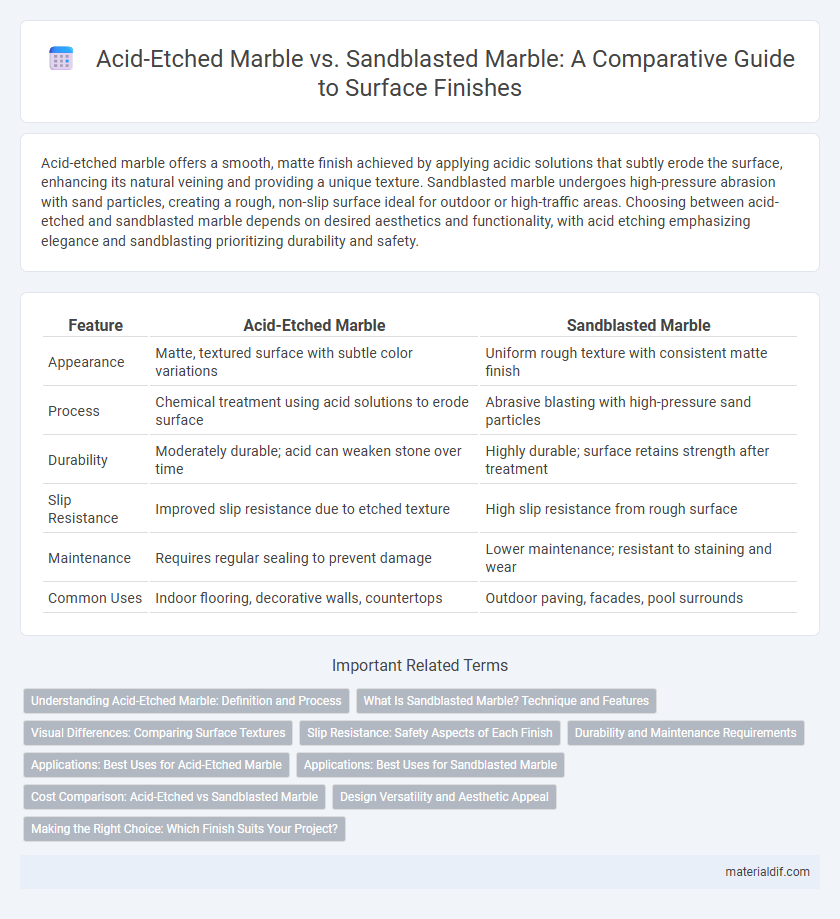Acid-etched marble offers a smooth, matte finish achieved by applying acidic solutions that subtly erode the surface, enhancing its natural veining and providing a unique texture. Sandblasted marble undergoes high-pressure abrasion with sand particles, creating a rough, non-slip surface ideal for outdoor or high-traffic areas. Choosing between acid-etched and sandblasted marble depends on desired aesthetics and functionality, with acid etching emphasizing elegance and sandblasting prioritizing durability and safety.
Table of Comparison
| Feature | Acid-Etched Marble | Sandblasted Marble |
|---|---|---|
| Appearance | Matte, textured surface with subtle color variations | Uniform rough texture with consistent matte finish |
| Process | Chemical treatment using acid solutions to erode surface | Abrasive blasting with high-pressure sand particles |
| Durability | Moderately durable; acid can weaken stone over time | Highly durable; surface retains strength after treatment |
| Slip Resistance | Improved slip resistance due to etched texture | High slip resistance from rough surface |
| Maintenance | Requires regular sealing to prevent damage | Lower maintenance; resistant to staining and wear |
| Common Uses | Indoor flooring, decorative walls, countertops | Outdoor paving, facades, pool surrounds |
Understanding Acid-Etched Marble: Definition and Process
Acid-etched marble is created by applying acidic solutions to the stone's surface, which chemically react with the marble to produce a textured, matte finish. This process enhances slip resistance while preserving the marble's natural veining and color variations. Unlike sandblasted marble, which uses high-pressure abrasive materials for surface roughening, acid etching alters the stone on a molecular level, resulting in a softer, more subtle surface texture.
What Is Sandblasted Marble? Technique and Features
Sandblasted marble is a surface treatment where fine grains of sand are propelled at high pressure to create a textured, non-slip finish that enhances durability and aesthetic appeal. This technique produces a rough, matte surface that resists wear and weathering, making it ideal for outdoor applications like walkways and patios. The sandblasting process exposes the marble's natural grain patterns, offering a subtle, elegant look with increased traction compared to smooth or polished finishes.
Visual Differences: Comparing Surface Textures
Acid-etched marble features a subtly matte and slightly rough surface with softened edges that enhance its natural veining, creating a muted, elegant appearance. Sandblasted marble displays a more pronounced textured finish with a uniformly rough and granular feel, delivering a weathered, tactile visual impact. The key visual difference lies in acid etching's smoother, understated finish versus sandblasting's bold, gritty surface texture.
Slip Resistance: Safety Aspects of Each Finish
Acid-etched marble offers a moderately slip-resistant surface by chemically etching the stone to create a textured finish, enhancing grip in wet areas while maintaining its natural appearance. Sandblasted marble delivers a more pronounced rough texture through abrasive blasting, providing superior slip resistance ideal for high-traffic or outdoor environments. Both finishes improve safety, but sandblasting generally ensures better traction on slippery surfaces, reducing accident risks in commercial and residential applications.
Durability and Maintenance Requirements
Acid-etched marble features a chemically treated surface that creates a matte finish but tends to be less durable due to increased porosity, requiring regular sealing and careful cleaning to prevent staining and etching. Sandblasted marble undergoes a mechanical abrasion process that produces a rough texture with enhanced slip resistance and generally offers greater durability against wear and weathering, demanding less frequent maintenance. Choosing between acid-etched and sandblasted marble involves balancing desired surface texture with the level of upkeep, as acid-etched surfaces need more vigilant care to maintain their appearance over time.
Applications: Best Uses for Acid-Etched Marble
Acid-etched marble is ideal for interior flooring, wall cladding, and bathroom surfaces due to its smooth, matte finish that enhances slip resistance while maintaining elegance. This treatment is particularly suited for areas requiring subtle texture without compromising the stone's natural beauty, making it a popular choice in residential and commercial settings. Unlike sandblasted marble, acid-etched marble provides a finer, more controlled surface ideal for polished interior applications.
Applications: Best Uses for Sandblasted Marble
Sandblasted marble is ideal for exterior applications such as walkways, patios, and pool surrounds due to its enhanced slip resistance and textured finish. Its durability against weathering makes it suitable for outdoor facades and architectural details where both aesthetics and safety are priorities. This finish also works well in commercial spaces requiring a robust yet elegant flooring solution.
Cost Comparison: Acid-Etched vs Sandblasted Marble
Acid-etched marble typically involves a chemical process that makes it cost-effective for achieving a textured surface with subtle, matte finishes, often priced lower than sandblasted options. Sandblasted marble undergoes a mechanical process using high-pressure abrasive materials, resulting in a rougher texture and higher labor and equipment costs, which generally increase its price. When comparing costs, acid-etching provides a budget-friendly solution for decorative effects, whereas sandblasting demands a premium investment due to the intensive preparation and durable results.
Design Versatility and Aesthetic Appeal
Acid-etched marble features a matte, weathered surface achieved through acid treatments that enhance intricate design details and offer a subtle, elegant appearance ideal for sophisticated interior applications. Sandblasted marble provides a rougher, textured finish by propelling sand particles at high speed, creating a more rugged, non-slip surface suited for both decorative and functional outdoor elements. Both finishes deliver versatile design options, with acid-etched marble excelling in refined, delicate patterns and sandblasted marble enhancing tactile contrast and durability for aesthetic appeal in various architectural settings.
Making the Right Choice: Which Finish Suits Your Project?
Choosing between acid-etched marble and sandblasted marble depends on the desired texture and visual effect for your project. Acid-etched marble offers a smooth, matte finish that enhances subtle elegance, while sandblasted marble provides a rougher, more pronounced texture that improves slip resistance and adds a rustic appeal. Consider the functional needs and aesthetic goals of your space to select the finish that best complements your design vision.
Acid-Etched Marble vs Sandblasted Marble Infographic

 materialdif.com
materialdif.com